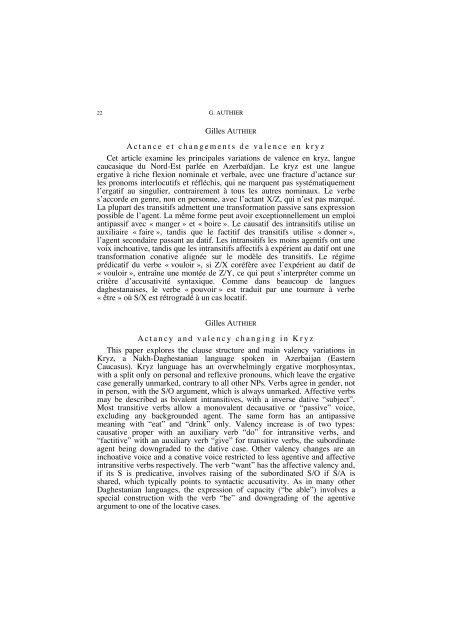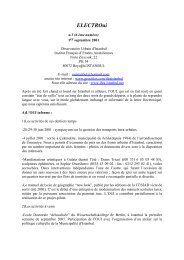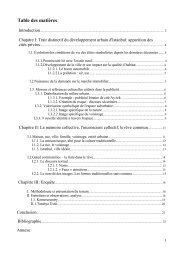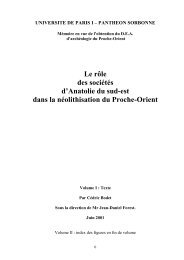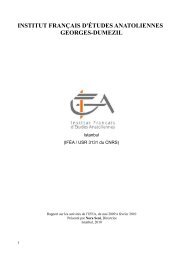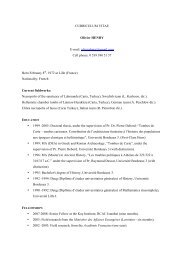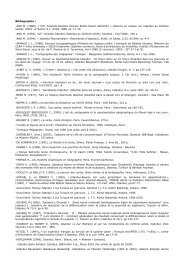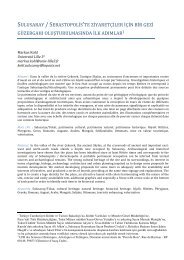ACTANCE ET CHANGEMENTS DE VALENCE EN KRYZ Gilles - IFEA
ACTANCE ET CHANGEMENTS DE VALENCE EN KRYZ Gilles - IFEA
ACTANCE ET CHANGEMENTS DE VALENCE EN KRYZ Gilles - IFEA
You also want an ePaper? Increase the reach of your titles
YUMPU automatically turns print PDFs into web optimized ePapers that Google loves.
22<br />
G. AUTHIER<br />
<strong>Gilles</strong> AUTHIER<br />
A c t a n c e e t c h a n g e m e n t s d e v a l e n c e e n k r y z<br />
Cet article examine les principales variations de valence en kryz, langue<br />
caucasique du Nord-Est parlée en Azerbaïdjan. Le kryz est une langue<br />
ergative à riche flexion nominale et verbale, avec une fracture d’actance sur<br />
les pronoms interlocutifs et réfléchis, qui ne marquent pas systématiquement<br />
l’ergatif au singulier, contrairement à tous les autres nominaux. Le verbe<br />
s’accorde en genre, non en personne, avec l’actant X/Z, qui n’est pas marqué.<br />
La plupart des transitifs admettent une transformation passive sans expression<br />
possible de l’agent. La même forme peut avoir exceptionnellement un emploi<br />
antipassif avec « manger » et « boire ». Le causatif des intransitifs utilise un<br />
auxiliaire « faire », tandis que le factitif des transitifs utilise « donner »,<br />
l’agent secondaire passant au datif. Les intransitifs les moins agentifs ont une<br />
voix inchoative, tandis que les intransitifs affectifs à expérient au datif ont une<br />
transformation conative alignée sur le modèle des transitifs. Le régime<br />
prédicatif du verbe « vouloir », si Z/X coréfère avec l’expérient au datif de<br />
« vouloir », entraîne une montée de Z/Y, ce qui peut s’interpréter comme un<br />
critère d’accusativité syntaxique. Comme dans beaucoup de langues<br />
daghestanaises, le verbe « pouvoir » est traduit par une tournure à verbe<br />
« être » où S/X est rétrogradé à un cas locatif.<br />
<strong>Gilles</strong> AUTHIER<br />
A c t a n c y a n d v a l e n c y c h a n g i n g i n K r y z<br />
This paper explores the clause structure and main valency variations in<br />
Kryz, a Nakh-Daghestanian language spoken in Azerbaijan (Eastern<br />
Caucasus). Kryz language has an overwhelmingly ergative morphosyntax,<br />
with a split only on personal and reflexive pronouns, which leave the ergative<br />
case generally unmarked, contrary to all other NPs. Verbs agree in gender, not<br />
in person, with the S/O argument, which is always unmarked. Affective verbs<br />
may be described as bivalent intransitives, with a inverse dative “subject”.<br />
Most transitive verbs allow a monovalent decausative or “passive” voice,<br />
excluding any backgrounded agent. The same form has an antipassive<br />
meaning with “eat” and “drink” only. Valency increase is of two types:<br />
causative proper with an auxiliary verb “do” for intransitive verbs, and<br />
“factitive” with an auxiliary verb “give” for transitive verbs, the subordinate<br />
agent being downgraded to the dative case. Other valency changes are an<br />
inchoative voice and a conative voice restricted to less agentive and affective<br />
intransitive verbs respectively. The verb “want” has the affective valency and,<br />
if its S is predicative, involves raising of the subordinated S/O if S/A is<br />
shared, which typically points to syntactic accusativity. As in many other<br />
Daghestanian languages, the expression of capacity (“be able”) involves a<br />
special construction with the verb “be” and downgrading of the agentive<br />
argument to one of the locative cases.


